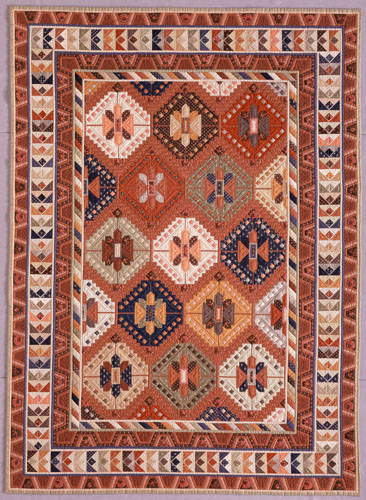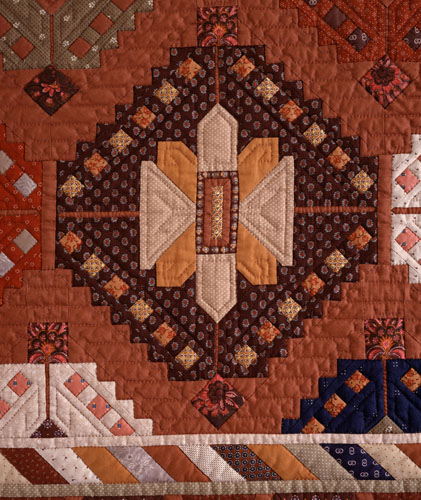
QUILT INDEX RECORD
25-21-77
Who documented this quilt?
Texas Sesquicentennial Quilt Association, Texas Quilt Search
Where are the records for this quilt housed?
Briscoe Center for American History, University of Texas at Austin
Texas Quilt Search Number:
tqs_0109
Person filling out this form is:
Quiltmaker; Quilt owner; Other
Source of the information on this quilt:
This quilt was reviewed and documented during the Texas Sesquicentennial Quilt Association's Phase II of the Texas Quilt Search, 1986-1989. Karey Bresenhan served as quilt historian.
When was the form filled out?
1986-1989
Choose the best description of the source to the quilt:
Quiltmaker; Quilt owner
How did the quiltmaker participate in the creation of the quilt?
Made entire quilt
If you are the quilt owner, how did you acquire this quilt?
Made the quilt
If the source helped design the quilt, describe their input:
Designed quilt motif; Designed the pattern
Describe the relationship to the quilt's maker:
This quilt is currently owned by the quiltmaker.
This is a:
Finished quilt
Quilt's title:
Shiraz Quilt
Owner's name for quilt:
Shiraz
How wide is the quilt?
69 in.
How long is the quilt?
96 in.
Shape of edge:
Straight
Shape of corners:
Straight
What color is the quilt?
Blue or Navy; Gold; Gray; Green; Rust; White
Overall color scheme:
Multicolor
Quilt's condition:
Excellent/like new
Time period:
1976-1999
When was the quilt finished?
1983
Family/owner's date for quilt:
1983
Describe the quilt's layout:
Medallion or framed center
Number of quilt blocks:
13 full blocks within framed medallion
Arrangement of quilt blocks:
On point or rotated on 45 degrees
Spacing of quilt blocks:
Separated by inner only sashing (no sashing along outer edge of outer blocks)
Describe the quilt setting:
framed blocks are a center medallion
Number of different block patterns used in the quilt:
1
What is the shape of the quilt blocks?
Diamonds
Number of borders:
4
Describe the borders:
Four elaborately hand-pieced borders feature a barber-pole stripe, running angular vines, and a main border in Flying Geese pattern.
Fiber types used to make the quilt top:
Cotton
Fabric types used to make the quilt top:
Broadcloth
Fabric styles used in the quilt top:
Dotted; Paisley; Print; Solid/plain
Piecing techniques used to make the quilt top:
Hand Piecing
Can you feel or see paper on the quilt that was used as a construction aid?
no
Materials used to make the back:
Cotton
Describe the back:
Same fabric used throughout
Materials used in the quilt binding:
Cotton
What is the width of the binding (measure on the top only)?
less than a half inch
What kind of filling is used in the quilt?
Polyester
How thick is the quilt?
Medium (3/16?)
How are the layers held together?
Hand quilting
Thread type used for the quilting:
cotton
Number of quilting stitches per inch, place 1:
7
Number of quilting stitches per inch, place 2:
9
Width between quilting lines:
often less than 1/2 in.
Can you see any knots on the front or back of the quilt?
no
Quilting designs used, overall motifs:
Outline
Quilting designs used, decorative motifs:
Vines; Other
Describe the quilting designs used:
Heavily quilted by hand using outline quilting inside of some pieces, serpentine shapes, latch hooks, and running vines, all repeating the Oriental motifs seen in piecing.
Features or notes about the quilt's appearance, materials, or construction:
The quiltmaker describes her pattern as follows: "Shiraz is a blending of two textile art forms--the Oriental carpet and quilts. The challenge was in manipulating colors and fabrics to create intricate geometric shapes. The central design is based on the eight-pointed star, although it has evolved and changed through many centuries. The blocks are set on point, with stepped sides. The stars are surrounded by twenty-four small (3/4 inch) squares, which give the illusion of lace or lightness to the blocks. The borders include a barber-pole stripe, running vines, and a main border of stylized floral motifs. Rugs from the villages around the Persian city of Shiraz provided the inspiration for this quilt."
Quilt top made by:
Cloninger, Judy Parrish
Quilted by:
Cloninger, Judy Parish
Where the quilt was made, city:
Taylor Lake Village
Where the quilt was made, county:
Harris
Where the quilt was made, state:
Texas (TX)
Where the quilt was made, country:
United States
How was this quilt acquired?
Made by owner
Tell the story of how the quilt was obtained:
Judy Cloninger intended for her Shiraz Quilt to blend two forms of textiles: Oriental carpets and quilts. This quilt pattern was inspired by rugs from around the villages around the Persian city of Shiraz.
Describe anything about the history of the quilt that wasn't already recorded in a previous field:
Judy Cloninger taught herself to quilt in 1969, and the renewed interest in handcrafts such as quilting in the mid 1970s furnished her "with fabrics, information, and shared enthusiasm." She enjoys the challenge of making intricate quilts such as her Shiraz Quilt, which took her some 2000 hours to complete.
Why was the quilt made?
Art or personal expression
The quilt was made to be used for:
Artwork/wall hanging
Quilt is presently used as:
Artwork/wall hanging; Exhibit; Study or teaching aid
Where did the maker get their materials?
Purchased new
Where did the maker find their pattern?
Original to maker
Describe anything about the design of the quilt that wasn't already recorded in a previous field:
Mrs. Cloninger notes: "In my quilt Shiraz, I seek to capture the timeless beauty of geometric designs found in Oriental rugs. Through my interest in the decorative arts, I have long been aware of the enduring appeal of Oriental carpets. Moving to Texas in the early 1970s provided me with an opportunity to learn in depth about quilts. My research into both fields of rugs and quilts gradually revealed their similarity and design compatability. By melding classic patterns and inspiration with contemporary fabrics and techniques, I try to create unique and beautiful quilts.
Exhibitions where this quilt was displayed:
“Lone Stars: A Legacy of Texas Quilts, 1936-1986,” 16th Annual International Quilt Festival, November, 1990, Houston, Texas.
Contests entered:
Best of Show, Founder's Award, First Place Pieced Division, Second Place Viewer's Choice, South/Southwest Quilt Association Judged Show, 1983.
Related items such as diaries, obituaries, wills, household inventories, or pictures of the quiltmaker:
Texas Sesquicentennial Quilt Association’s Texas Quilt Search Archives
Publications (including web sites) where this quilt or maker was featured:
Bresenhan, Karoline Patterson and Nancy O'Bryant Puentes, Lone Stars: A Legacy of Texas Quilts, Vol. II, 1936-1986 (Austin: University of Texas Press, 1990), p. 118-119; Quiltmakers 1989 (1989 Calender, Leone Publications); "Designing Oriental Quilts," in Threads Magazine no. 17, June/July 1988, pp.46-51; Great American Quilts, 1987 (Oxmoor Press, 1987), p. 34-39; Bishop, Lehman, Bresenhan, Hands All Around: Quilts from Many Nations (1987), p. 86; Quilter's Newsletter Magazine, April 1979, p. 25.
Ownership of this quilt is:
Private
Quilt owner's name:
Judy Parrish Cloninger
Quilt owner's state:
Texas (TX)
Quilt owner's country:
United States
Quiltmaker's maiden name:
Parrish, Judy
Quiltmaker's gender:
Female
Quiltmaker's birth date:
08/08/1941
Quiltmaker's birthplace, city:
Nashville
Quiltmaker's birthplace, state:
Tennessee
Quiltmaker's birthplace, country:
United States
Quiltmaker's educational background:
University of South Florida, BA, with honors, 1963
Quiltmaker's occupation:
urban planner; quilt teacher, lecturer
In which kind of environment did the quiltmaker live?
Urban
Quiltmaker's state:
Texas (TX)
Quiltmaker's country:
United States
Quiltmaker's spouse's/spouses' and /or partner's/partners' name(s):
Cloninger, Dale O.
Quiltmaker's spouse's/spouses' and/or partner's/partners' occupation:
professor
Number of children:
2
How many of the quiltmaker's children were boys?
2
How did the quiltmaker learn to quilt?
From Class; Self-Taught
When did the quiltmaker learn to quilt?
Age 20-29
Why does the quiltmaker quilt?
Gifts; Income; Pleasure
Notes on how the quiltmaker learned, and how and why they quilt:
"The aesthetic enjoyment of the quilts which contain designs inspired by art objects I have long admired. I also enjoy the challenge of creating complex designs from simple materials and techniques."
Estimated number of quilts made by this quiltmaker:
20-50 quilts
Does/did the quiltmaker sell quilts?
yes
Does/did the quiltmaker teach quilting?
yes
Any other notes or stories about the quiltmaker:
Taught at Quilt Festival in Houston, 1981, 1984-85, 1987-88, as well as at festivals and workshops in Nashville and Oakland.
Who photographed this quilt?
Sharon Risedorph
Access and copyright information:
Restricted
Copyright holder:
Assistant Director Winedale
Details
Cite this Quilt
Cloninger, Judy Parris. Shiraz Quilt. 1983. From Briscoe Center for American History, University of Texas at Austin, Texas Sesquicentennial Quilt Association, Texas Quilt Search. Published in The Quilt Index, https://quiltindex.org/view/?type=fullrec&kid=25-21-77. Accessed: 04/25/24
-
Gallery
Unusual Pattern names
Sikarskie, Amanda Grace
